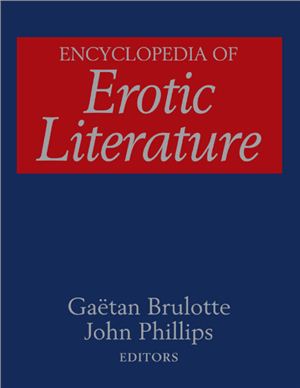Routledge Taylor & Francis Group, New York London, 2006.
TABLE OF CONTENTS
Advisors
Introduction
List of Contributors
A to Z List of Entries
Thematic Table of Contents
Entries A to Z
Index
Erotic literature is a global cultural expression represented in nearly all literary forms from the ancient world to the present. Recognizing its rich scope and cultural importance, scholars from around the world are drawn to the genre and the study of erotic literature is now a vast and emerging field. In these two volumes, the Encyclopedia of Erotic Literature invites the reader to embark on the scholarly exploration of a genre that traverses the horizon of human sexual experience, transforming our understanding of such experience and the experience of literature as well.
This encyclopedia is the first of its kind: a comprehensive discussion and scholarly analysis of those innumerable works, written in many different languages throughout our known history, in which ‘sex-talk’ is the dominant discourse. The history of this discourse is as old as the history of writing itself.
During the six years since its inception, this project has attracted considerable intellectual interest from all over the globe. Leading scholars in the world’s most renowned universities have acted as advisors from an early stage, as well as contributing many of the 546 entries that make up the two volumes of the work. The total number of contributors exceeds
400. The conceptual framework determining the general organization of contents prior to its distribution in alphabetical order was divided into four categories: Historical Overviews, Topics and Themes, Literary Surveys, Writers and Works. Historical Overviews are categorized by language/ geographical or cultural area and ideally include all literary genres (e.g. the Ancient World or French Canadian Literature); Topics and Themes focus on a predominant or general subject in the field (e.g. Libertinism or Necrophilia) or a critical approach (such as Feminism or Queer Theory); Literary Surveys address genres, or publication issues (Pulp Fiction or Bibliographies, for instance), Writers and Works include individual entries on authors or works — whether attributed or anonymous—(D.H. Lawrence or Jin Ping Mei, for example), which address their relation to the history of the genre as a whole, and evaluate their contribution to it. Each entry offers a set of bibliographical references and suggested further readings. With very few exceptions, the length of entries varies from a minimum of 1000 words to a maximum of 8000 words, according to the relative importance of the subject-matter.
TABLE OF CONTENTS
Advisors
Introduction
List of Contributors
A to Z List of Entries
Thematic Table of Contents
Entries A to Z
Index
Erotic literature is a global cultural expression represented in nearly all literary forms from the ancient world to the present. Recognizing its rich scope and cultural importance, scholars from around the world are drawn to the genre and the study of erotic literature is now a vast and emerging field. In these two volumes, the Encyclopedia of Erotic Literature invites the reader to embark on the scholarly exploration of a genre that traverses the horizon of human sexual experience, transforming our understanding of such experience and the experience of literature as well.
This encyclopedia is the first of its kind: a comprehensive discussion and scholarly analysis of those innumerable works, written in many different languages throughout our known history, in which ‘sex-talk’ is the dominant discourse. The history of this discourse is as old as the history of writing itself.
During the six years since its inception, this project has attracted considerable intellectual interest from all over the globe. Leading scholars in the world’s most renowned universities have acted as advisors from an early stage, as well as contributing many of the 546 entries that make up the two volumes of the work. The total number of contributors exceeds
400. The conceptual framework determining the general organization of contents prior to its distribution in alphabetical order was divided into four categories: Historical Overviews, Topics and Themes, Literary Surveys, Writers and Works. Historical Overviews are categorized by language/ geographical or cultural area and ideally include all literary genres (e.g. the Ancient World or French Canadian Literature); Topics and Themes focus on a predominant or general subject in the field (e.g. Libertinism or Necrophilia) or a critical approach (such as Feminism or Queer Theory); Literary Surveys address genres, or publication issues (Pulp Fiction or Bibliographies, for instance), Writers and Works include individual entries on authors or works — whether attributed or anonymous—(D.H. Lawrence or Jin Ping Mei, for example), which address their relation to the history of the genre as a whole, and evaluate their contribution to it. Each entry offers a set of bibliographical references and suggested further readings. With very few exceptions, the length of entries varies from a minimum of 1000 words to a maximum of 8000 words, according to the relative importance of the subject-matter.

